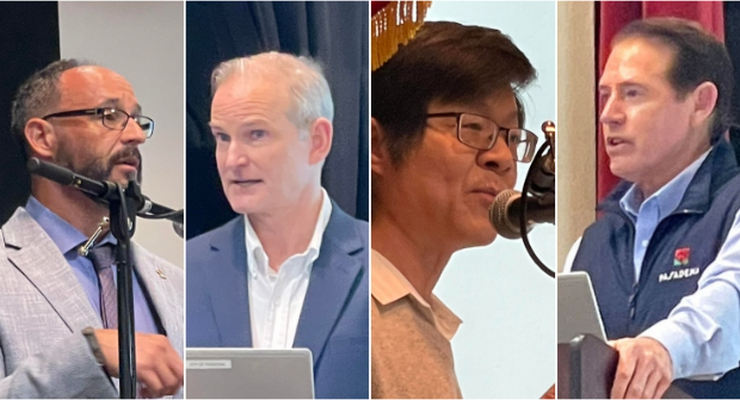
[UPDATED] After being honored for his 25th anniversary as a member of the Pasadena City Council, Vice Mayor Steve Madison Wednesday introduced a high-powered panel of experts for his District Town Hall — an in-depth update on Pasadena’s goal of creating a carbon-free city by 2030.
The panel included Pasadena Water and Power Department Acting General Manager David Reyes; a keynote from California Institute of Technology Professor Steven Low; and a panel discussion featuring Chris Yeh of California Institute of Technology, Will McNamara of Sandia National Laboratories, and Cynthia Cannady of Pasadena 100. The proceedings were moderated by journalist and community advocate Wes Reutimann.
Each speaker agreed that California and in particular, the City of Pasadena, are well on their way to achieving their energy saving goals.
Madison alluded to Pasadena’s sheer brain power: “I’ve always said that if Pasadena can’t solve a problem, then who can?”
Keynote speaker Low, a professor of Computing Science, Mathematics, and Electrical Engineering, discussed the importance of “decarbonizing,” or eliminating fossil fuels from energy systems, to address the climate emergency.
Low emphasized the need to reduce greenhouse gas emissions from electricity generation and transportation, which together account for more than half of all emissions.
“For a long time,” Low explained, in what was essentially a mini-class lecture before the rapt audience, “say, the last 10,000 years, the carbon dioxide content in the atmosphere stays at roughly 280 or lower parts per million by volume. And then 1900 came along, it started to shoot up extremely fast. It is at 420 today. So,” he said, pointing to a chart, “this is the history over the last 10,000 years, and we can see that the rate at which it goes up has been extremely fast.”
Low also highlighted the correlation between temperature rise and greenhouse gas emissions, and the role of human activities, particularly energy use, in driving this temperature increase. He also discussed the challenges and solutions for achieving a zero-carbon grid, including the electrification of transportation and the generation of clean, renewable electricity.
Additionally Low mentioned the impressive potential of distributed energy resources, such as batteries, electric vehicles, and smart devices, to optimize the electricity grid’s efficiency and stability.
McNamara of Sandia National Laboratories, a federally funded national laboratory under the Department of Energy, discussed the role of energy storage in decarbonization, explaining that decarbonization is “a shift from traditional reliance on fossil fuels to renewable energy sources like solar and wind.”
McNamara highlighted the importance of “Long Term Energy Storage (LDES)” in making renewable resources “dispatchable,” and smoothing out fluctuations in the electrical grid. He also discussed the need for LDES technologies as the nation’s reliance on renewables increases.
Sandia National Laboratories is currently leading a three-year initiative focused on LDES technologies, funded by the Department of Energy, said McNamara, who also mentioned the Inflation Reduction Act, a federal stimulus package that provides funding for clean energy projects, including tax credits for public power utilities.
“What Sandia National Laboratories is doing to help communities,” said McNamara, “is that we support state energy offices, public utility commissions, and also public power utilities. We help them in several different ways. One is to examine where funding opportunities might exist through the federal government, and we’re at a terrific point in our history that there is more funding available now than ever before, and that really helps absorb the costs that flow down to customers.”
Yeh, a Ph.D. student at California Institute of Technology, explained that his research is “more on the AI side, but a lot of my applications are focused on energy systems,” particularly in creating algorithms for predicting electricity demand.
Yeh explained that California often generates more electricity from renewables than it consumes. “This can lead to wasted energy and money,” he said, suggesting that better battery storage could capture this wasted energy.
Yeh also highlighted the issue of inaccurate net demand forecasts, meaning that since power companies buy power on a day-before basis, that pricing structure can lead to higher electricity prices in real-time markets. Yeh also suggested that AI could improve these forecasts, reducing costs for utilities and consumers.
Yeh also noted that California produces a surprisingly large amount for negative electricity prices in California due to its sheer amount of solar generation, and suggests that predicting these prices could optimize battery and electric vehicle charging times.
Yeh explained that on Wednesday at 2 p.m. in Pasadena, California was producing so much solar energy that wholesale electricity prices in Pasadena were negative at -$45 per megawatt-hour.
Finally, Yeh discussed the potential for AI to predict carbon emissions and optimize electricity use at the lowest emissions times.
Cannady, a founding member of Pasadena 100, also delivered a confident and optimistic progress report on the group’s 2030 carbon-free goal.














 49 comments
49 comments



